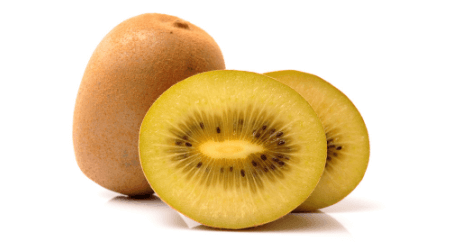Kiwi Fruit and Plant Guide
Kiwi is a well known fruit. But it’s the Fuzzy Kiwi that everyone recognizes! Did you know that the Fuzzy Kiwi has a fuzz-less cousin called the Hardy Kiwi? Both the Fuzzy and Hardy Kiwi provide excellent fruit. Both are pest and disease free, and easy-to-grow. Altogether, there are three types of Kiwi plants.
the Fuzzy Kiwi is the variety found in grocery stores. The Hardy Kiwi provides a fruit the size of a large grape that tastes like…Kiwi! That can be eaten skin-and-all. the Arctic Kiwi fruit is the size of a raisin.
Kiwis benefits are well studied. Vitamin C is OFF-THE-CHART, and Kiwi fruit is high in folic acid (Vitamin B-9), Vitamin E and potassium. it improves digestive health (gastrointestinal disorders) and metabolic health (cholesterol, hypertension, vascular inflammation, abnormal glucose).
This Kiwi Fruit and Plant Guide shows you everything on ONE ad-free webpage: know it, grow it, or sell it! Welcome to HEPPY™!
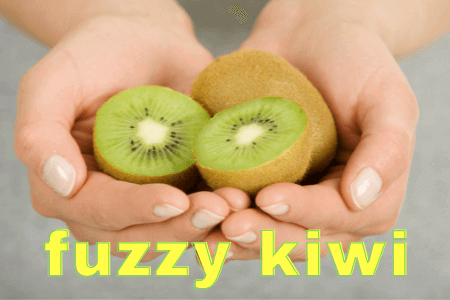
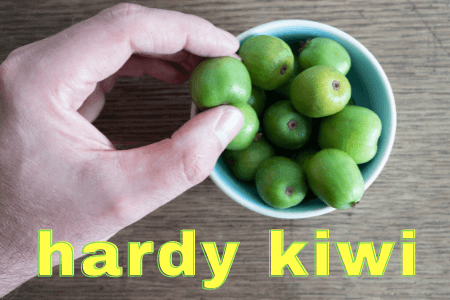
Kiwi Guide on ONE ad-free webpage!
On this page:
1. Kiwi Fact Sheet: Fuzzy Kiwi and Hardy Kiwi
2. Types of Kiwi Plants
3. Kiwi in landscaping and garden ideas.
4. Eating Kiwi and its medicinal qualities.
5. Kiwis benefits.
6. Commercial viability.
7. Kiwi Plant Guide for Care and Maintenance.
8. Propagating Kiwi.
9. Varieties that we grow organically right now!
________________________________________
see our list of 400 edible plants
YouTube channel (please subscribe)
YouTube playlist for Kiwi (please subscribe)
Fuzzy Kiwi Fact Sheet
common names: Kiwi, Kiwifruit, Chinese Gooseberry.
Zone: 7 to 9 (zone 7 for some cultivars)
Height: Long (prune to size; 8 to 10 feet minimum)
Native: no
Bloom Time: May – June
Bloom Color: White
Fruit Maturity: November – December
Self-fertile: no (except the cultivar, Jenny)
Sun: full sun to part shade
Water: medium (soil dependent)
Soil: forgiving (must drain well)
Maintenance: low
Growth Rate: fast
Deciduous or evergreen: deciduous
Edible¹: yes
Medicinal²: yes
Commercial viability: strong
Family / Genus (species): Actinidiaceae / Actinidia (Actinidia deliciosa)
Remarks: attractive and large fuzzy leaves; a very forgiving plant in well-drained soil; grows fast but much less pruning than the Hardy Kiwi.


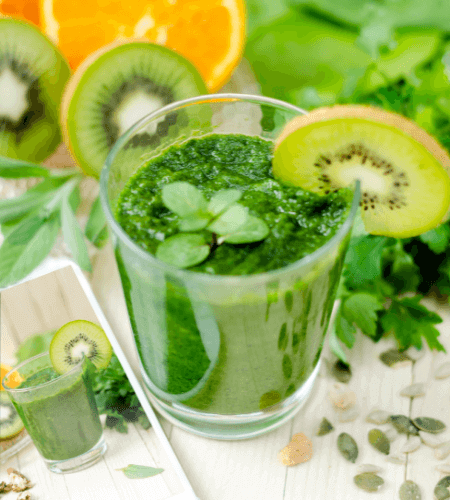
Hardy Kiwi Fact Sheet

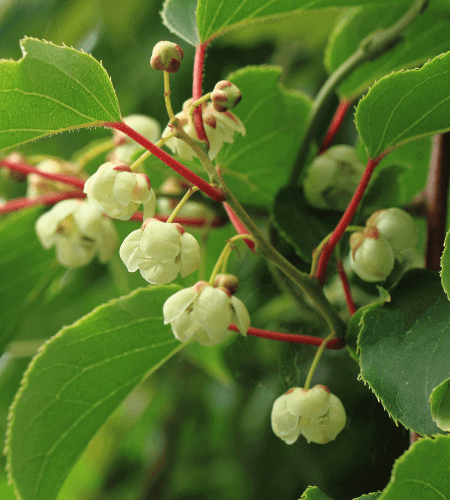
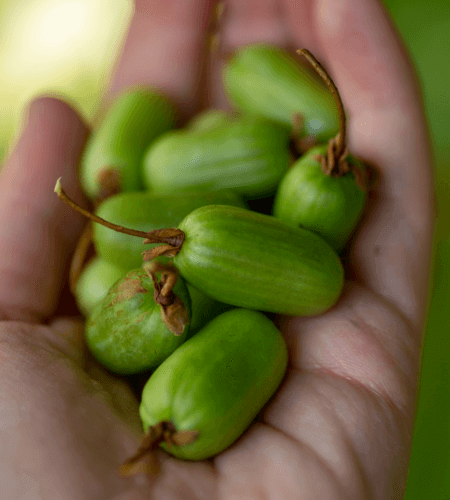
common names: Kiwi, Tara Vine.
Zone: 3 to 8
Height: Long vine (grows 20′ long)
Native: no
Bloom Time: May – June
Bloom Color: White
Fruit Maturity: October – November
Self-fertile: no (except the cultivar, Issai)
Sun: full sun to part shade
Water: medium (soil dependent)
Soil: forgiving (must drain well)
Maintenance: low
Growth Rate: rocket fast
Deciduous or evergreen: deciduous
Edible¹: yes
Medicinal²: yes
Commercial viability: strong
Family / Genus (species): Actinidiaceae / Actinidia (Actinidia arguta)
Remarks: excellent green screen; grows very fast so pruning is a factor in smaller spaces; a very forgiving plant in well-drained soil.
Types of Kiwi — Arctic, Fuzzy and Hardy
all three types are NOT native to North America. they are fast growing vines and well leaved / attractive. the fruit is famous for its high sugar content and exceptional flavor! except for pruning, they require little care. all three thrive in full sun but can tolerate part-shade. Also, all three require a male and female plant to produce fruit (there are rare exceptions, such as the Jenny Fuzzy Kiwi and Issai Hardy Kiwi).
the major distinctions are fruit-size: the Fuzzy produces the largest fruit; the Hardy a produces very large grape sized fruit; and the Arctic produces a tasty fruit the size of a raisin.
Three Types of Kiwi Plants
Arctic Kiwi (Actinidia kolomikta)
also called the Variegated-leaf Hardy Kiwi and Kolomikta, this species is native to East China, Japan and East Siberia.
the foliage produces a reddish tints. its attractiveness in summer becomes showier when autumn approaches. like the Hardy Kiwi (Actinidia arguta) the Arctic Kiwi grows fast. And it’s extremely cold-hardy — able to tolerate -40 degrees F.
white flowers are very attractive but small. it will flower in June (Northern Hemisphere). the Arctic Kiwi is not self-fertile. it produces a sweet fruit the size of a raisin. the plant grows long vines — at least 30 feet long! we have no experience growing the Arctic Kiwi (Actinidia kolomikta). it’s not common but we’ll add it to HEPPY’s plant portfolio ;).
Actinidia kolomikta cultivars include Arctic Beauty, Pasha, Red Beauty, and September Sun.
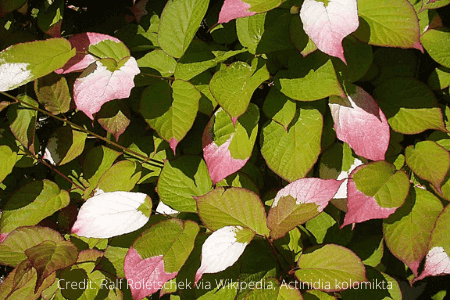
Fuzzy Kiwi (Actinidia deliciosa and Actinidia chinensis)
also called the Kiwi, Kiwifruit or Chinese Gooseberry. This species is native to China. it is China’s national fruit (along with the Jujube, Ziziphus zizyphus). the fruit was mentioned in a 16th century Chinese medicine encyclopedia, the Compendium of Materia Medica. the plant was introduced to New Zealand in 1904 and eventually, renamed from the Chinese Gooseberry to the Kiwifruit.
this is the variety found in grocery stores. 4.3M tons of Fuzzy Kiwi was produced in 2018. of the 3 types of Kiwi, the Fuzzy is bigger in every way. the leaves, flowers and fruit are bigger. and the leaves, stems and new growth have a distinct ‘fuzz’ — fuzzy hairs. much like what’s on the fruit’s skin. UNLKIE the Arctic and Hardy, it does not grow as long as quickly. it’s more manageable. and, the Fuzzy is not nearly as cold-tolerant as the Arctic and Hardy.
Fuzzy Kiwis are either green or gold on the inside. Actinidia deliciosa are green on the inside and are sold at many nurseries. very uncommon (in the States) are varieties that are gold on the inside, Actinidia chinensis. pictures on the right show that Actinidia deliciosa is fuzzier 😉
NOT all Green Fuzzy Kiwis grow in zone 7. in zone 7, a young Fuzzy Kiwi may need protection over its first winter. we’ve had no issues with our cultivar, Vincent (in zone 7). I read that the Gold Fuzzy Kiwi grows in zone 6. at the time of writing (2022), I cannot find a live plant for sale in the States. get one if you can — it would be valuable!
Actinidia chinensis cultivars include AU Golden Dragon (aka, Jinnong. pollinate with AU Arthur), AU Golden Sunshine (aka, Jinyang. pollinate with AU Golden Tiger), Hort16A (Zespri Gold). these are NOT easy to find 🙁
Actinidia deliciosa cultivars include Abbott, Allison, Bruno, Elmwood, Jenny, Hayward (VERY popular), Saanichton, and Vincent.
Hardy Kiwi (Actinidia arguta)
also called the Tara Vine, this species is native to East China, Japan and East Siberia.
there are several cultivars; the Issai is the only self-pollinating Hardy Kiwi and its vines are far less aggressive than other cultivars. all Hardy Kiwi are cold-hardy — able to tolerate -25 degrees F.
white flowers are very attractive but small. it will flower in May-June (Northern Hemisphere). it produces a sweet fruit the size of a very large grape. you can eat the kiwi skin. the fruit tastes like a kiwi grapes!
the plant shoots-out long vines — at least 30 feet long! it requires continuous pruning’ prune the Hardy Kiwi at least every two months.
Actinidia arguta cultivars include Anna (Ananasnaya), Chang Bai, Cordifolia, Dumbarton Oaks, Flowercloud, Geneva, Issai, Ken’s Red, Meader, Michigan State, Natasha, Ogden Point, Rossana, Tatyana, and 74-49.
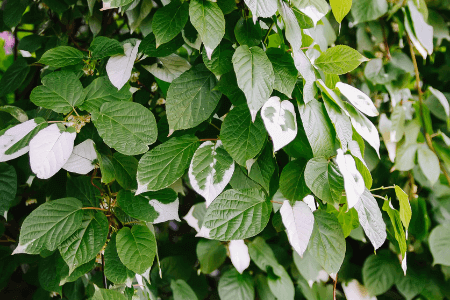
Kiwi in landscaping and garden ideas
need a green screen? well, this is the vine. want to fill-in an arbor or trellis. then the Kiwi is your plant (pruning not withstanding 😉
Kiwi grow vigorously so its location in landscaping and garden design must be thought-through. and, the soil must be well-drained (organic, sand / sandy-loam, sloped terrain, etc.).
Landscape Architecture
in landscape architecture, Kiwi are a long-vined plant. it needs space, and pruning will be required to maintain it’s shape.
the Fuzzy or Issai Hardy Kiwi are ideal candidates as ornamental, fruiting vines on an arbor. the Fuzzy Kiwi grows more gently — it’s less “all over the place.” the Issai Hardy Kiwi is a far more gentle Hardy Kiwi (it does not grow a wildly as other hardy Kiwi cultivars). the Arctic Kiwi are grown mainly for their attractive, pink-variegated foliage and fragrant flowers.
however, this is your plant if you have a long space to fill. use a trellis of some sort; for example, use a trellis as if your growing grapes. in time, a Kiwi plant will fill a 200 sq. ft. trellis.
set plants 15 feet apart. if fruit is desired, then plant a male Kiwi intermittently. it is FULLY disease and pest free at HEPPY™. it is a reliable and low-maintenance fruiting vine EXCEPT for pruning. See How to Grow Kiwi below.
Garden Ideas
if space is limited, then we recommend the Fuzzy or Issai Hardy Kiwi. find a sunny location if you want optimal flowering & fruit.
Kiwis are disease/pest free so NO spray or chemicals are needed. they do appreciate a good watering when it get’s hot and dry; they are not drought tolerant. they do not like ‘wet feet’ so don’t over water. we grow Kiwis in high organic soil (another reason for vigorous growth). however, the Hardy Kiwi will tolerate many types soils, including infertile soil.
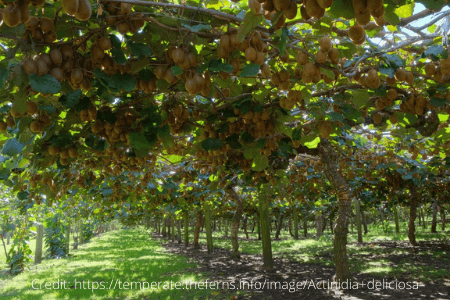
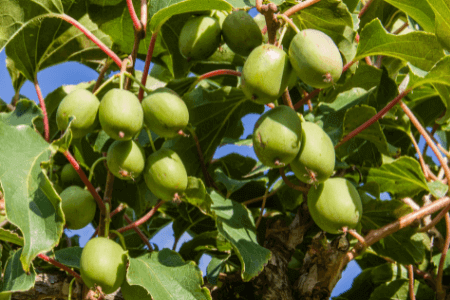
Hardy Kiwi are extremely winter hardy but develop shoots early in the spring that are sensitive to frost. loosing shoots is one thing; however, fruit will not develop if flowers are frosted.
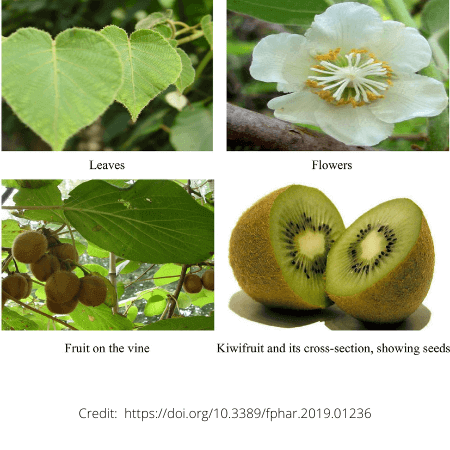
How to Eat Kiwi Fruit
1, 2 HEPPY cannot take any responsibility for any adverse effects from the use of plants. Always seek advice from a professional before using a plant for food or medicinally. This information is intended for educational purposes only and should not be considered as a recommendation or an endorsement of any particular medical or health treatment.
Edible fruit
Kiwi fruit is easy to pick, refrigerates well, and can be frozen or dehydrated! Kiwi fruit is used as an appetizer, in salads, and in fish, fowl and meat dishes. or, use Kiwi fruit in pies, puddings, cake-filling, or ice cream. or in beverages! Kiwi fruit blends into any food.
to eat a fresh Kiwi fruit:
1. give the fruit a gentle squeeze while on the vine. it’s ripe if the fruit ‘gives’ a little (is slightly soft or, yields to the touch). fully ripe fruits can be kept for a week or more in the home refrigerator. check-out our YouTube vid where I eat fresh Kiwi over the Christmas holiday season!
2. pick a mature Kiwi fruit when it’s hard and place it on a counter until it softens (until slightly soft; a very soft fruit is over-ripe). keep the fruit in a cool location out of the sun. refrigerate excess fruit to eat later. firm fruits can be kept 8 weeks at room temperature, 65º to 70º F (18.33º-21.11º C).
Fuzzy Kiwi fruit can be frozen or dehydrated:
for freezing, store in a standard zip-lock bag. the flavor is improved if peeled and immersed for 3 minutes in a solution of 12% sucrose, 1% ascorbic acid, and 0.25% malic acid (derivative of apple or pear), and quickly frozen.
dehydration at temperatures below 150º F is recommended.
Recipes
How about a Kiwi Margarita or in a Green Tea Smoothie? Kiwi Sorbet or a Kiwi Salsa Verde? the State of California posted many tasty recipes.
thirty (30) extraordinary recipes, like Crab Cake Sliders with Pineapple-Kiwi Salsa, are here (website with minimal ads).
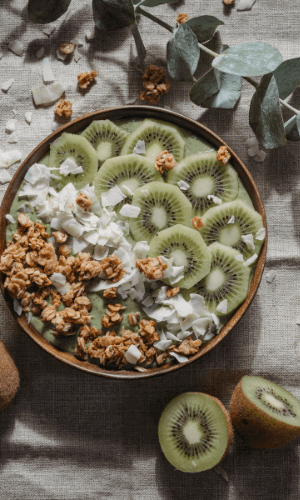

Kiwis benefits
1, 2 HEPPY cannot take any responsibility for any adverse effects from the use of plants. Always seek advice from a professional before using a plant for food or medicinally. This information is intended for educational purposes only and should not be considered as a recommendation or an endorsement of any particular medical or health treatment.
Kiwi fruit are a nutrient-dense fruit and extensive research on the health benefits of kiwi fruit found benefits to digestive, immune and metabolic health (NIH / PubMed, “The nutritional and health attributes of kiwifruit: a review”). The study looked at the Fuzzy Kiwi, Actinidia deliciosa.
Caution: Fuzzy kiwi fruit has the enzyme, Actinidin. it has “been known to cause allergic reactions ranging from mild symptoms localized to the oral mucosa in the majority of individuals to anaphylactic reactions, particularly in children.” (NIH / PubMed, “The nutritional and health attributes of kiwifruit: a review”).
Kiwis benefits include high amounts of Vitamin C, folic acid and potassium. Kiwi fruit is also rich in Vitamin E and dietary fiber.
Vitamin C
Vitamin C is THREE TIMES higher than Oranges. the Kiwi fruit’s Vitamin C content is the most distinctive nutritional quality of Kiwi fruit. the graph on the right shows Kiwis benefits. the amount of Vitamin C is much higher when compared to other commonly consumed fruit.
we need Vitamin C for many biological functions. “Vitamin C is a cofactor of metallo-enzymes necessary for the biosynthesis of collagen, l-carnitine, catecholamine, neurotransmitters, and peptide hormones such as oxytocin….The strong antioxidant properties of Vitamin C are well documented, it scavenges free radicals and other reactive oxygen and nitrogen species, with a capacity to regenerate other small molecule antioxidants from their respective radicals.” (The nutritional and health attributes of kiwifruit: a review).
Folate (Vitamin B-9)
Only Papaya and Oranges compare in Folate. folate is in green leafy vegetables but is easily destroyed by cooking. folate intake via fresh fruit is a important to the total diet. the graph on the right shows Kiwis benefits. the amount of folate is much higher when compared to most commonly consumed fruit.
folate is especially important “during pregnancy when it is difficult to meet folate requirements” (The nutritional and health attributes of kiwifruit: a review). “Folate is important in red blood cell formation and for healthy cell growth and function. The nutrient is crucial during early pregnancy to reduce the risk of birth defects of the brain and spine (Mayo Clinic / Folate (folic acid)).
Potassium
only the banana has more Potassium! fresh fruit provides potassium AND low sodium, which makes eating kiwi fruit (Banana and Papaya) so valuable. the graph on the right shows Kiwis benefits. the amount of potassium when compared to other commonly consumed fruit.
“Potassium is an essential mineral that is needed by all tissues in the body. It is sometimes referred to as an electrolyte because it carries a small electrical charge that activates various cell and nerve functions….Its main role in the body is to help maintain normal levels of fluid inside our cells. Sodium, its counterpart, maintains normal fluid levels outside of cells. Potassium also helps muscles to contract and supports normal blood pressure (Harvard School of Public Health / Potassium).
Kiwis benefits include Vitamin E (“high levels of vitamin E when compared to other commonly consumed fruit”). Kiwi fruit has antioxidants, dietary fiber and minor proteins. benefits of Kiwi fruit includes improved digestive health (gastrointestinal disorders) and metabolic health (cholesterol, hypertension, vascular inflammation, abnormal glucose). NIH / PubMed, “The nutritional and health attributes of kiwifruit: a review.”

commercial viability of the Kiwi
the marketing has been done for YOU! the State of California, New Zealand, and other businesses groups market this fruit!
Farmers' market or cottage food industry
potential products are FAR ranging. and I would argue that it’s a wonderful novelty fruit to make preserves or jams, and I’ve read that it can be baked into goods. or, sell fresh fruit.
selling fresh fruit is convenient because the Fuzzy Kiwi hangs on the plant well. Pawpaw, for example, falls off the tree once ripe. we’ve had a few fruit remain on the vine into January! also, fresh kiwi fruit transports well. pick them when mature but firm. handle with moderate care and there’s no bruising.
Hardy Kiwi is best if picked moderately soft. so handling and transporting would be an issue. as of today, we have not picked mature but firm Hardy Kiwi fruit to evaluate how it softens indoors.
Commercial or private landscaping
Fuzzy Kiwi is ideal for a overhead trellis or arbor-type structure. also, it’s a novelty plant to consider. for example, not ONE person I’ve met knew that Fuzzy Kiwi grew here in Maryland, zone 7.
Hardy Kiwi is a green screen on steroids. few plants are needed to cover a wide space. don’t want fruit? then plant only males or only females. vines need pruning so consider the amount of space you’re working with! we prune the Hardy Kiwi at least once per two months; the Fuzzy Kiwi is pruned on the same schedule far fewer vines must be pruned.

Kiwi: how to grow, train, prune, and eat Kiwi fruit
Kiwis are easy-to-grow vines. but they require well-drained soil, time before bearing fruit, a trellis system, and pruning. on a ‘easy-to-grow scale’, the easiest Kiwi plant to grow is the Issai Hardy Kiwi. Fuzzy Kiwi are next. all other Hardy Kiwi (not Issai) require that you to invest time. the benefits far out-weigh the time we invest.
Growing Kiwi

grow Kiwi in well drained soil organic soil. however, they don’t like ‘wet feet’ (wet soil). we grow Kiwi in high organic soil, and on semi-raised beds. our beds are on a slope, so it’s “raised” to one side. this allows for excellent drainage which is important Kiwi. Hardy Kiwi will tolerate unfertile soil.
Kiwi plants are NOT drought tolerant but cannot be overwatered. we water our Kiwis during the hottest summer periods. we wait until the leaves droop a little, and then we know it’s time to water.
if growth seems to lag, or if leaves are pale, supplement with a pound of soy or cottonseed meal per plant in late spring or early summer (thank you Edible Landscaping).
have a trellis system of some kind. for posts, we drove 6′ long rebar into the soil, then slipped bamboo poles over the rebar. then, we used a not-so-thick wire to span between the poles. it’s a LESS than ideal design as mature Kiwi plants requires firm support (or, more pruning :(.
Bear fruit
Fuzzy Kiwi take 2-4 years before they bear fruit. in 2016, we started with a male and female plant in 4″ pots. by 2019 we harvested a bowl of fruit. by 2020 we needed a pail to harvest fruit from the one female Kiwi plant.
Hardy Kiwi take about 3-5 years before bearing fruit.
the Issai is the exception; it is interestingly different (self-pollinator, fruits in 1-2 years after planting, and grows less vigorously as it’s Hardy Kiwi ‘cousins’).
Training Kiwi Plants
training Kiwi plants is critical. you can see from the pictures that it takes preparation and time.
Fuzzy Kiwis require less effort because they grow less vigorously than the Hardy Kiwi. except Issai, Hardy Kiwi require you to prepare for a vine that can grow 15 foot vines in one year.
training kiwi plants:
1. trellis system: we recommend the t-bar (overhead) or espalier (flat) trellises.
(due to their location in the garden, we use the espalier trellis to grow Hardy Kiwi, and the t-bar trellis top grow the Fuzzy.)
2. main trunk: in the plant’s first year, train ONE shoot as the main trunk. remove all other shoots from the base of the plant.
3. lateral growth (“Cordons”): in the plant’s first and second year, select the most vigorous shoots — shoots that grow OFF OF the main trunk — and train them to grow on the trellis’ wire supports. these are called, cordons.
the main trunk and cordons create the Kiwi plant’s structure. you will prune around them. shoots growing off the cordons are the source of your fruit! 😉
Pruning Kiwi Plants
pruning Kiwi plants is a continuous task. we use two methods: a quick and strategic prune. it’s difficult to overprune a Kiwi plant.
Kiwi plants send-out shoots throughout the growing season. except for the Issai, Hardy Kiwi erupt like nuts. also, shoots may be called watersprouts or canes. we’ll called them shoots.
Hardy Kiwi send-out 30-50 shoots from cordons or the main trunk. and, they grow long! any nearby plant will have this Hardy Kiwi vine on it.
Fuzzy Kiwi send-out about half the number of shoots. and, the shoots do not grow as long.
HEPPY’s quick prune:
at least once per two months we simply cut the 6-8foot shoots back to the cordon. it’s that simple. pruning more often — let’s say, monthly — has the added benefit on the cut shoots decomposing faster. the vines are very soft (the base of a shoot becomes slightly woody at two months).
strategic prune:
winter pruning is essential to create strong and productive plants. it directs energy into making fruit.
we follow the expert’s advice, and perform this task annually. we prune strategically when the Kiwi plant is dormant. Oregon State University provides a comprehensive guide to pruning Kiwi (starting at page 22).
How to eat kiwi
in this video i eat Fuzzy Kiwi in December. we harvest the fruit a month before and allowed them to soften n the home.
check-out the video’s chapter descriptions.
0:00 intro
1:02 when to pick Fuzzy Kiwi?
1:40 selecting ripe Fuzzy Kiwi
2:03 how to cut a kiwi
2:13 peel a fuzzy kiwi
2:24 SIZE difference between Fuzzy and Hardy kiwis
3:22 GROWTH difference between Fuzzy and Hardy kiwis
3:34 Hardy Kiwi is considered an INVASIVE in the Northeast
4:00 eating a firm Fuzzy Kiwi
and more, in the video!!!
Propagate Kiwi: cuttings, division, grafting, layering and seeding
propagate Kiwi by seed, grafting or softwood cutting. at HEPPY™, we’ve had limited success ground layering Hardy Kiwi. at the time of writing (2022), we’re yet
SEED Propagation
propagation by seed is common BUT the subsequent plant show great variation. germination rates are high. plants grown this way are idea for rootstock (for budding or grafting at a later date).
to gather small seeds, ripe fruits are pulped in an electric blender and then the pulp is strained through a fine screen. mix seeds in moist sand, place in a zip-lock bag refrigerate for 2 weeks. then, plant the mix (seed/sand) and kept moderately moist. Germination will take 2 to 3 weeks.
SOFTWOOD Propagation
softwood cuttings are taken in June – July. select from the current season’s growth and do not select too near the tip of a shoot (growth at the tip will be green — that’s too immature). use standard methods: select 3-5 nodes; remove all leaves but one or two from the top; trim away 1/2 inch of bark tissue at the lower part of the cutting; dip in rooting hormone (liquid is best); and set the softwood in the appropriate soil (sterile, and heavy in perlite, vermiculite, sand or peat moss). set in a shady location and misting the cuttings is important. Thank you to Arlie A. Powell, Horticulturist-Fruits, Auburn University for the general outline for propagating Kiwi plants by softwood.
LAYERING Propagation
HEPPY™ had limited success with ground layering Fuzzy and Hardy Kiwi. about 20-40% of the mature vines began growing. and, to took a year before I could clearly see it was growing.
at the time of writing (2022), we’re yet to transplant these propagated plants. we have no true evaluation of how similar they are to parent plant. we assume identical but….
we’ll make a vid this year — stay tuned!! please subscribe to our YouTube playlist for Kiwi.
Kiwi growing at HEPPY™


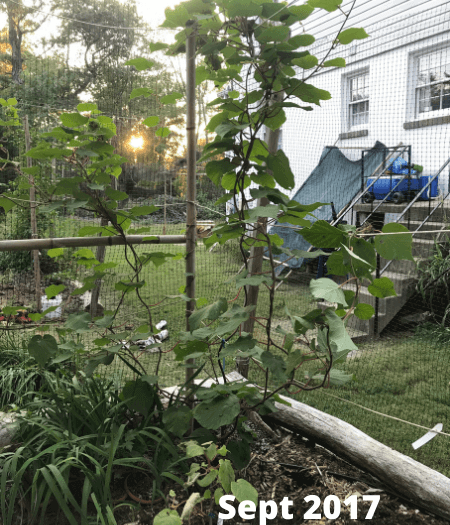
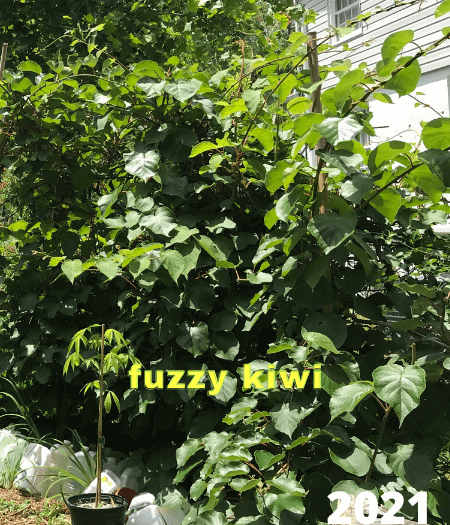
Fuzzy Kiwis
we purchased a female cultivar, Vincent and a male (Matua) in 2016. the pots were a minuscule 4″, and $12 each. by 2017 we had tall healthy plants and picked fruit by 2020. i recommend NOT starting with a 4″ 😉 our two Fuzzies were purchased from Edible Landscaping.
our spacing is very tight. the optimum spacing is 10-15 feet between plants. spacing provides more light (more fruit) and air circulation to reduce risk of disease. (however, note that we have ZERO pests or disease on the Fuzzy and Hardy Kiwis.)
our next task will be to build a T-Bar trellis and have vines grow overhead. we’ll make a vid of it — stay tuned!
now, after 5 years, we fill 2/3rds of a 5-gallon bucket of fruit from our ONE female Fuzzy (the cultivar, Vincent).
Kiwi plants benefit from rich soil. we spread compost or manure around plants in early spring.
Hardy Kiwi
we purchased two female cultivars, Anna, Issai and Ken’s Red, and a male in 2017. they were purchased from various local nurseries — 2 or 3 gallon pots for $30 to $40 each!
these were mature plants (2-3 gallon pots). so by spring 2019 we saw a few flowers. by 2020 we picked a few fruit. and by October 2021 we picked a full, small bowl of fruit every 2-3 days.
Hardy Kiwi ripen intermittently. they grow in clusters — up to 10 fruit per cluster. some fruit in the cluster will be ripe and other are not. they become slightly shriveled when ripe so you need to touch each fruit. give a slightly shriveled fruit a squeeze and if it gives, it’s ready!
our 4 Hardy Kiwis are planted ridiculously close to one another. they are intended to be ‘parent’ plants to produce cuttings that we’ll grow and sell.
no pests / no disease — not even an aphid!

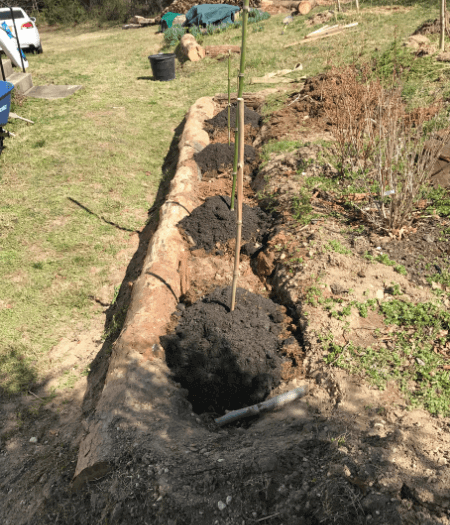
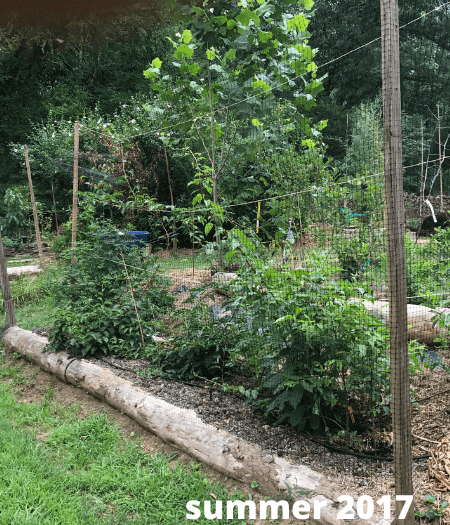
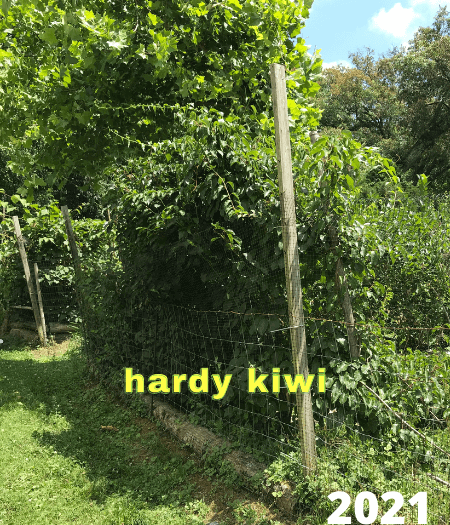
References
Missouri Botanical Garden: Arctic (Actinidia kolomikta) | Fuzzy (Actinidia deliciosa) | Hardy (Actinidia arguta)
Plants for a Future: Arctic (Actinidia kolomikta) | Fuzzy (Actinidia chinensis) | Fuzzy (Actinidia deliciosa) | Hardy (Actinidia arguta)


